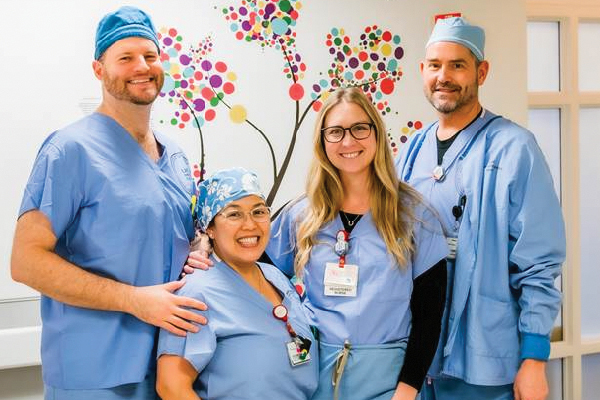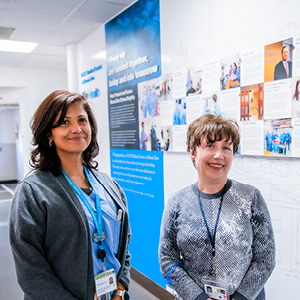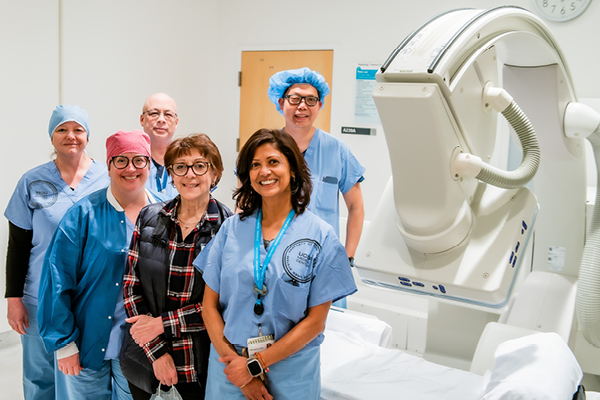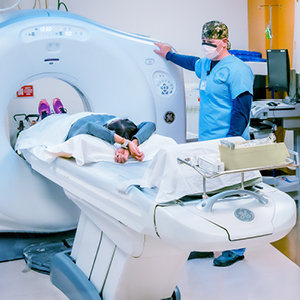Mount Zion is Once Again an Inpatient Hospital Where Imaging Plays an Important Role

The resumption of in-patient care at Mount Zion Hospital in 2020 after many years as an outpatient site presented an opportunity for imaging expansion. The pandemic-provoked transformation was not the first time this hospital has reinvented itself in its long history. On November 3, 1887, 43 members of San Francisco’s Jewish community met for the first time to plan a hospital in the San Francisco area, "for the purpose of aiding the indigent sick without regard to race or creed, to be supported by the Jewish community." The hospital, dubbed Mount Zion, was given the mission to practice healing, grounded in learning and supported by acts of personal kindness. In 1990, UCSF acquired Mount Zion, more than a century after its founding as San Francisco’s first Jewish hospital.
When COVID-19 began to spread in California in March 2020, Mount Zion sprang into action, opening an intensive care unit and two acute care units to provide capacity in case of a surge. However, San Francisco’s success at “flattening the curve” and slowing the initial speed of the pandemic meant that much of that capacity was not needed.
When Mount Zion Hospital went 24/7, all the imaging modalities based there had to become quite creative, working together to develop plans for how to provide full services even with temporarily reduced staff levels. Leading imaging’s organizational response during this transition were David Sostarich, Radiology Operations Director, Jessica Pfannenstiel, BSRT (R)(CT), Manager of CT Operations, Tosca Bridges, M.S., R.T.(R)(CT)(QM), Chief Manager of Diagnostic Radiology, Craig DeVincent, R.T.(MR), Manager of MRI, Amy Vincent, BS, R.T.(M), Chelsy Coco, BS, RDMS, Manager of Ultrasound, Alpana Patel Camilli, BS, CRA, RT (CT), Manager of Interventional Radiology and Neuroendovascular Surgery.
 Alpana described the Mount Zion radiology teams in familial terms, “We’ve always known that we are a part of something greater here: a family, a community. Mount Zion has a smaller footprint than other UCSF operations. The departments and modalities are closely located so the various modality staff know each other well, creating a unity that is hard to match.” Cooperation between the modality leaders and their respective teams was the key foundation for making the transition successful. Alpana described it so, “The Diagnostic, CT, MRI, Ultrasound and Mammography leadership were all part of the remarkable joint effort that enabled Mount Zion’s transformation. One of the wonderful aspects of Mount Zion is the modalities are not so separated. This physical proximity helps bring on a collegial atmosphere.”
Alpana described the Mount Zion radiology teams in familial terms, “We’ve always known that we are a part of something greater here: a family, a community. Mount Zion has a smaller footprint than other UCSF operations. The departments and modalities are closely located so the various modality staff know each other well, creating a unity that is hard to match.” Cooperation between the modality leaders and their respective teams was the key foundation for making the transition successful. Alpana described it so, “The Diagnostic, CT, MRI, Ultrasound and Mammography leadership were all part of the remarkable joint effort that enabled Mount Zion’s transformation. One of the wonderful aspects of Mount Zion is the modalities are not so separated. This physical proximity helps bring on a collegial atmosphere.”
Supervisors and managers took the lead to provide coverage, as the teams used an all-on-call process to staff the gaps. Radiology technologists with experience in multiple modalities were the key, as their knowledge and adaptability provided the flexibility to meet this new level of demand. These skills are still being cultivated; two diagnostic techs are currently cross training in interventional radiology, several diagnostic techs successfully trained in MRI and CT. When orthopedic services first expanded at Mount Zion, the technologists, X-Ray & CT techs in particular, needed to shuffle and stretch operations to quickly match the demand. Yet despite these extraordinary demands, the team fell into place and executed the transition with efficiency and unfailing professionalism.

Mount Zion radiology fosters a learning environment with a feeling of unity and a loyal community among its physicians, staff, and technologists. Chester Lim, Diagnostic Supervisor, has been a part of the team since the onset of Mount Zion operation, over 20 years ago. Those who work with Chester have called him, “the heart and soul of the department.” Chester has helped train dozens of techs through his own valuable experience, providing classes on positioning and patient safety. This contribution is volunteered without having ‘educator’ anywhere in his official title. Alpana noted that Chester “is extremely passionate about education and this is his contribution, his legacy at UCSF. He obtains great satisfaction from seeing the students graduate, pass their board exams, and then apply for a role with us at UCSF. Chester is the person to contact if something unexpected happens or something goes wrong.”
Yelena Borodina, known as Lena to her coworkers and friends, is the Mount Zion Site Manager, responsible for imaging administration and facilities coordination. She is also the best person to educate anyone on the organizational history of the hospital from its earliest days to the present, even though Lena’s official offices are located in the Breast Imaging section at Mission Bay. Camilli observed that, “Lena has a vision and a passion for supporting people that allows her to work so well together with campus and medical.”
Camilli remarked that team members like Chester and Lena are crucial to Mount Zion’s thriving: “Our teams embrace change and view workflows and practices through the lens of continuous improvement. We directly involve our respective teams in the improvement process. For example: have your team follow a workflow idea suggested by the technologist or nurse. Have the team provided feedback at the end of the day; can any step be adjusted or fine-tuned? We create an environment where it is allowable to stumble, and then to try again.”
 Mount Zion may not be the largest medical center at UCSF, but it is busy. At Mount Zion, imaging includes X-ray, MRI, CT, bone density, ultrasound, mammography, and interventional radiology provided at the Main Hospital Building on Divisadero Street, the Women’s Health Center on Sutter Street, and the Medical Offices Building on Post Street. Mount Zion imaging recently added two MRI resources (a 3T and 1.5T) to accommodate advanced studies, with additional imaging services in the planning stages. Change is a constant at Mount Zion, with Camilli observing that, “We understand that flexibility and adaptation are strengths for us to foster as we move into the future. It is the individuals of our department that contribute to those hundreds of small steps that will move us all together in the right direction.”
Mount Zion may not be the largest medical center at UCSF, but it is busy. At Mount Zion, imaging includes X-ray, MRI, CT, bone density, ultrasound, mammography, and interventional radiology provided at the Main Hospital Building on Divisadero Street, the Women’s Health Center on Sutter Street, and the Medical Offices Building on Post Street. Mount Zion imaging recently added two MRI resources (a 3T and 1.5T) to accommodate advanced studies, with additional imaging services in the planning stages. Change is a constant at Mount Zion, with Camilli observing that, “We understand that flexibility and adaptation are strengths for us to foster as we move into the future. It is the individuals of our department that contribute to those hundreds of small steps that will move us all together in the right direction.”
